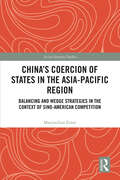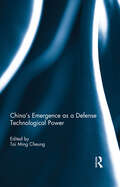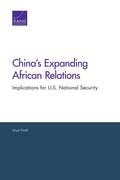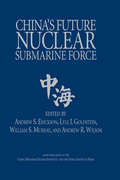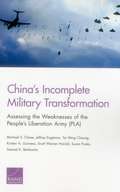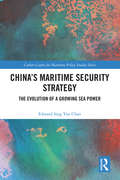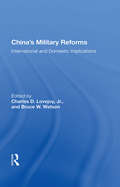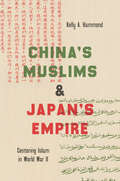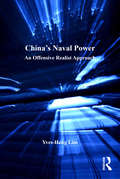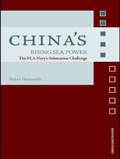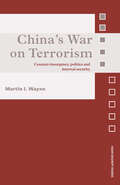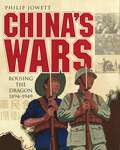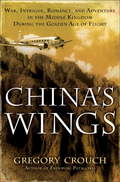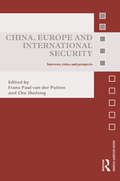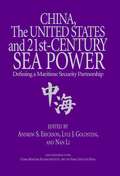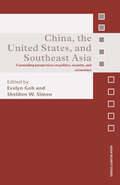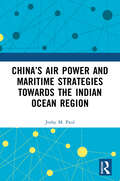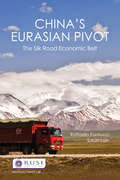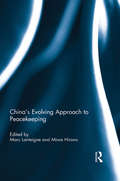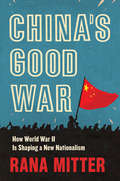- Table View
- List View
China's Coercion of States in the Asia-Pacific Region: Balancing and Wedge Strategies in the Context of Sino-American Competition (Asian Security Studies)
by Maximilian ErnstThis book explains why China chooses to coerce Asia-Pacific regional states, despite the risk of such actions creating a backlash and complicating its strategic calculus.China’s coercion of neighboring states, often a variation of heavy informal economic sanctions combined with diplomatic pressure and gray-zone coercive measures, has been increasingly observable in the past decade. It has become an important tool in China’s foreign policy toolbox and is frequently used by Beijing to shape the security-political environment of the Asia-Pacific. The book begins with an appreciation of China’s complicated geopolitical exposition and an understanding that such coercion creates backlash, since the target state will likely be alienated and pushed into closer security cooperation with the United States, China’s main geopolitical rival. Through two in-depth case studies of Chinese coercion, targeting the Philippines and South Korea, respectively, the book demonstrates that, first, the reason China coerces is that the secondary state engages in actions that fundamentally threaten China’s security interests, and, second, it will coerce these states only if other policy options geared to change the secondary state’s course of action have not worked. Employing balance-of-power theory, and particularly wedge strategies, the book solves a pertinent research question and improves our knowledge of contemporary security politics in the Asia-Pacific.This book will be of interest to students, scholars and practitioners of Asia-Pacific security, Chinese foreign policy, and international relations.
China's Emergence as a Defense Technological Power
by Tai Ming CheungChina is flexing its growing military and strategic clout in the pursuit of broadening national security interests. At the same time, the country’s economic and technology policies have also become more nationalistic, state-centered, and ambitious. China’s defense economy has set its sights on catching up with the West by the beginning of the 2020s and is making steady progress in building up its innovation capabilities, although this is presently in the form of incremental and sustaining types of activities. More high-end, disruptive forms of innovation that would lead to major breakthroughs are likely to be beyond China’s reach in the near-to medium term. This volume provides a wide-ranging and detailed assessment of the present state of the Chinese defense economy at a time of rapid change and accelerating advancement in its innovation capabilities and performance. This collection of articles has three main goals: (1) to locate China’s defense innovation dynamics within broader historical, technological and methodological frameworks of analysis; (2) to assess the performance of the Chinese defense economy’s six principal subsectors; and (3) to compare China’s approach to defense industrialization with major counterparts in the Asia-Pacific region.This book was originally published as a special issue of the Journal of Strategic Studies.
China's Expanding African Relations: Implications for U.S. National Security
by Lloyd ThrallAcross economic, political, and security domains, the growth of China's presence in Africa has been swift and staggering, which has fed both simplistic caricatures of China's role on the continent and fears of renewed geopolitical competition. A closer look reveals a more balanced picture. This report examines how China's growing engagement affects the United States' role in Africa and offers policy recommendations for U. S. military leaders.
China's First Emperor and His Terracotta Warriors
by Frances WoodThis biography of the ancient Chinese ruler delves into his life and times, chronicling his immortal achievements and reconsidering his legacy.Unifier or destroyer, lawmaker or tyrant? China’s First Emperor (258–210 BC) has been the subject of debate for over 2,000 years. He gave us the name by which China is known in the West and, by his unification or elimination of six states, he created imperial China.He stressed the rule of law but suppressed all opposition, burning books and burying scholars alive. His military achievements are reflected in the astonishing terracotta soldiers—an astonishing army of statues buried with the emperor. And his Great Wall still fascinates the world.Despite his achievements, however, the First Emperor has been vilified since his death. China’s First Emperor and His Terracotta Warriors describes his life and times and reflects the historical arguments over the real founder of China and one of the most important men in Chinese history.
China's Future Nuclear Submarine Force
by Andrew Wilson William S. Murray Goldstein Lyle J Andew S. EricksonOne of the key concerns of naval strategists and planners today is the nature of the Chinese geostrategic challenge. Conceding that no one can know for certain China s intentions in terms of future conflict, the editors of this hot-topic book argue that the trajectory of Chinese nuclear propulsion for submarines may be one of the best single indicators of China s ambitions of global military power. Nuclear submarines, with their unparalleled survivability, remain ideal platforms for persistent operations in far-flung sea areas and offer an efficient means for China to project power.This collection of essays presents the latest thinking of leading experts on the emergence of a modern nuclear submarine fleet in China. Each contribution is packed with authoritative data and cogent analysis. The book has been compiled by four professors and analysts at the U.S. Naval War College who are co-founders of the college s recently established China Maritime Studies Institute.Given the opaque nature of China s undersea warfare development, readers will benefit from this penetrating investigation that considers the potential impact of even the most revolutionary changes in Chinese nuclear submarine capabilities. The editors believe that to ignore such possibilities would be the height of strategic folly and represent inexcusable negligence in terms of U.S. national defense.Anyone who is interested in the future of the U.S. Navy and the defense of the United States will find this book to be essential reading.
China's Incomplete Military Transformation: Assessing the Weaknesses of the People's Liberation Army (PLA)
by Michael S. Chase Scott Warren Harold Samuel K. Berkowitz Jeffrey Engstrom Tai Ming Cheung Kristen A. Gunness Susan PuskaThrough extensive primary source analysis and independent analysis, this report seeks to answer a number of important questions regarding the state of China's armed forces. The authors found that the PLA is keenly aware of its many weaknesses and is vigorously striving to correct them. Although it is only natural to focus on the PLA's growing capabilities, understanding the PLA's weaknesses--and its self-assessments--is no less important.
China's Maritime Security Strategy: The Evolution of a Growing Sea Power (Corbett Centre for Maritime Policy Studies Series)
by Edward Sing ChanThis book examines the evolution of China’s maritime security strategy, and questions what has made China shift from a constrained to a more assertive strategy. Historically, China has not been an active player in maritime security, but in recent years Beijing has begun to pursue policies and measures to safeguard its maritime rights and interests in the Indo-Pacific region. This growing influence in the region has become a concern for other countries about what kind of sea power China is developing. This book seeks to address this concern by providing an overview of the development of China’s maritime security strategy from the era of Deng Xiaoping to Xi Jinping. It suggests that while the involvement of maritime actors and the development of naval capability have provided the depth to the strategy, the national strategic guidelines from each generation of Chinese leadership have determined the overall direction of the maritime security strategy. After 40 years of development, China has established a set of priorities for its maritime agenda: territorial integrity is at the top, followed by development, and then regional and international maritime cooperation. These findings help us to understand China’s multidimensional maritime power as being both assertive and cooperative. This book will be of much interest to students of naval strategy, maritime security, Chinese politics and International Relations.
China's Military Reforms: International And Domestic Implications
by Bruce W. Watson Charles D. LovejoyChina’s reform policies during the past decade have resulted in the reorganization of economic and political structures and have led to a dramatic reorientation of the nation’s foreign policy. These reforms have especially influenced China’s military establishment, which is now in a period of major transition. What new paradigm is replacing the old Maoist model of People’s War, however, is not clear. This book examines what China’s military modernization means for the global and regional balance of power and for China’s internal political-economic system. Specific chapters focus on changes in Chinese strategy and doctrine, developments in defense industries and military procurements, China’s acquisition of foreign technology, its military education system, and its nuclear weapons program.
China's Muslims and Japan's Empire: Centering Islam in World War II (Islamic Civilization and Muslim Networks)
by Kelly A. HammondIn this transnational history of World War II, Kelly A. Hammond places Sino-Muslims at the center of imperial Japan's challenges to Chinese nation-building efforts. Revealing the little-known story of Japan's interest in Islam during its occupation of North China, Hammond shows how imperial Japanese aimed to defeat the Chinese Nationalists in winning the hearts and minds of Sino-Muslims, a vital minority population. Offering programs that presented themselves as protectors of Islam, the Japanese aimed to provide Muslims with a viable alternative—and, at the same time, to create new Muslim consumer markets that would, the Japanese hoped, act to subvert the existing global capitalist world order and destabilize the Soviets. This history can be told only by reinstating agency to Muslims in China who became active participants in the brokering and political jockeying between the Chinese Nationalists and the Japanese Empire. Hammond argues that the competition for their loyalty was central to the creation of the ethnoreligious identity of Muslims living on the Chinese mainland. Their wartime experience ultimately helped shape the formation of Sino-Muslims' religious identities within global Islamic networks, as well as their incorporation into the Chinese state, where the conditions of that incorporation remain unstable and contested to this day.
China's Naval Power: An Offensive Realist Approach (Corbett Centre for Maritime Policy Studies Series)
by Yves-Heng LimThe rapid modernization of the Chinese Navy is a well-documented reality of the post-Cold War world. In two decades, the People's Liberation Army Navy has evolved from a backward force composed of obsolete platforms into a reasonably modern fleet whose growth is significantly shaking the naval balance in East Asia. The rationale behind China's contemporary rise at sea remains, however, difficult to grasp and few people have tried to see how the current structure of the international system has shaped Chinese choices. This book makes sense of Chinese priorities in its naval modernization in a 'robust' offensive realist framework. Drawing on Barry Posen's works on sources of military doctrine, it argues that the orientation of Beijing's choices concerning its naval forces can essentially be explained by China's position as a potential regional hegemon. Yves-Heng Lim highlights how a rising state develops naval power to fulfil its security objectives, a theoretical perspective that goes farther than the sole Chinese case.
China's Rising Sea Power: The PLA Navy's Submarine Challenge (Asian Security Studies)
by Peter HowarthThis is a fascinating insight into China’s strategic abilities and ambitions, probing the real depths of its plans for the twenty-first century. China's Rising Sea Power explores similarities between China’s strategic outlook today and that of earlier continental powers whose submarine fleets challenged dominant maritime powers for regional hegemony: Germany in two World Wars and the Soviet Union during the Cold War. Using insights from classical naval strategic theory, Peter Howarth examines Beijing’s strategic logic in making tactical submarines the keystone of China’s naval force structure. He also investigates the influence of Soviet naval strategy and ancient Chinese military thought on the PLA Navy’s strategic culture, contending that China’s increasingly capable submarine fleet could play a key role in Beijing’s use of force to resolve the Taiwan issue. This book will be of great interest to all students and scholars of security and strategic studies, Asian politics, geopolitics and military (naval) strategy.
China's War Reporters
by Parks M. CobleWhen Japan invaded China in 1937, Chinese journalists greeted the news with euphoria, convinced their countrymen, led by Chiang Kai-shek, would triumph. Parks Coble shows that correspondents underplayed China's defeats for fear of undercutting morale and then saw their writings disappear and themselves denounced after the Communists came to power.
China's War on Terrorism: Counter-Insurgency, Politics and Internal Security (Asian Security Studies)
by Martin I. WayneChina‘s war on terror is among its most prominent and least understood of campaigns. With links to the global jihad, an indigenous insurgency threatens the government‘s grip on a massive region of north- western China known as Xinjiang. Riots, bombings, ambushes, and assassinations have rocked the region under separatist and Islamist banners. China
China's Wars
by Philip JowettBy the end of the first decade of the 21st century, China had become one of the great powers of the modern world. Economically, politically, and militarily, its power and international reach is only exceeded by the United States, the world's one remaining superpower.Its military spending, though dwarfed by the United States, is over $100 billion a year and it is busy developing an aircraft carrier, a stealth fighter jet, and missiles that can shoot down satellites - all in an effort to project its power on a global scale.This is all a far cry from its position at the end of the 19th century, when it was a ramshackle and isolated medieval empire upon whom the European colonial powers could impose their wishes at will. The period from the First Sino-Japanese War of 1894-95 through to the Communist victory in the Chinese Civil War ending in 1949 was one of near-constant conflict that saw China emerge as a fledgling new world power. Militarily at least, this is the defining period in Chinese history.This is the period that saw the breakdown of the traditional imperial system of control, under threat from a series of rebellions throughout the 19th century, and the rise of the warlords and civil war in 1911. Despite the establishment of the Republic of China in 1912, the country was still riven by internal strife as different factions sought to control the fledgling state, while much of the power in the land was exercised by regional warlords in a constant state of conflict with one another. The 1920s saw the rise of two opposing revolutionary movements, the Kuomintang, led first by Sun Yat-Sen and later Chiang Kai-Shek, and the Chinese Communist Party, one of whose early leaders was Mao Tse-Tung. The Kuomintang managed to gain control of the majority of China by the late 1920s, and started a long running conflict with the Communists at the same time. The late 1920s also saw the first significant Japanese intervention in China, and in 1931 the Japanese took control of the whole of Manchuria. By 1937 this had escalated into out and out conflict with the Chinese, a conflict which would last till the Japanese defeat in World War II in 1945. Even then China had to struggle through four years of painful civil war before the Chinese Communist Party finally established control in 1949.In this new study Philip Jowett traces the complicated military history of China during these pivotal years, describing in detail the conflicts that forge the modern superpower that is China today.
China's Wings
by Gregory CrouchFrom the acclaimed author of Enduring Patagonia comes a dazzling tale of aerial adventure set against the roiling backdrop of war in Asia. The incredible real-life saga of the flying band of brothers who opened the skies over China in the years leading up to World War II--and boldly safeguarded them during that conflict--China's Wings is one of the most exhilarating untold chapters in the annals of flight. At the center of the maelstrom is the book's courtly, laconic protagonist, American aviation executive William Langhorne Bond. In search of adventure, he arrives in Nationalist China in 1931, charged with turning around the turbulent nation's flagging airline business, the China National Aviation Corporation (CNAC). The mission will take him to the wild and lawless frontiers of commercial aviation: into cockpits with daredevil pilots flying--sometimes literally--on a wing and a prayer; into the dangerous maze of Chinese politics, where scheming warlords and volatile military officers jockey for advantage; and into the boardrooms, backrooms, and corridors of power inhabited by such outsized figures as Generalissimo and Madame Chiang Kai-shek; President Franklin Delano Roosevelt; foreign minister T. V. Soong; Generals Arnold, Stilwell, and Marshall; and legendary Pan American Airways founder Juan Trippe. With the outbreak of full-scale war in 1941, Bond and CNAC are transformed from uneasy spectators to active participants in the struggle against Axis imperialism. Drawing on meticulous research, primary sources, and extensive personal interviews with participants, Gregory Crouch offers harrowing accounts of brutal bombing runs and heroic evacuations, as the fight to keep one airline flying becomes part of the larger struggle for China's survival. He plunges us into a world of perilous night flights, emergency water landings, and the constant threat of predatory Japanese warplanes. When Japanese forces capture Burma and blockade China's only overland supply route, Bond and his pilots must battle shortages of airplanes, personnel, and spare parts to airlift supplies over an untried five-hundred-mile-long aerial gauntlet high above the Himalayas--the infamous "Hump"--pioneering one of the most celebrated endeavors in aviation history. A hero's-eye view of history in the grand tradition of Lynne Olson's Citizens of London, China's Wings takes readers on a mesmerizing journey to a time and place that reshaped the modern world.
China, Europe and International Security: Interests, Roles, and Prospects (Asian Security Studies)
by Frans-Paul van der Putten Chu ShulongThis book examines the roles played by China and Europe in the domain of international security in the 21st century. Bringing together Chinese and European expertise on the Sino-European Security relationship , this book positions Europe - both the EU and the major national actors - and China in a global security context. It offers not merely an elaboration of the theme of bilateral security relations, but also introduces a wider view on Europe and China as global security actors. The chapters cover four main themes: the perceptions of and actual relations between Europe and China as security actors; relations of China and Europe with third parties such as the US, Russia, and Iran; Europe and China as actors in multilateral security approaches; Europe and China as (potential) security actors in each other’s technological domain or region. Given the increasingly prominent roles that both China and Europe play in international security as permanent members of the UN Security Council (in the European case, through the informal and partial representation of the UK and France), through their extensive global economic interests, and their important relations with the USA, this book provides a timely examination of the current state and future developments in the Sino-European relationship. This book will be of much interest to students of international security, Chinese politics, EU studies and IR in general.
China, the United States, and 21st-Century Sea Power
by Goldstein Lyle J Andew S. EricksonChina's rise on the world's oceans is attracting wide attention and may ultimately restructure the global balance of power during the course of the 21st century. Many books have described this phenomenon and the significant strategic implications that flow from Beijing's rapid maritime development. However, the subject of whether and how to potentially integrate a stronger China into a global maritime security partnership has not been adequately explored. Delving into a variety of vital domains of contemporary maritime security, American and Chinese contributors to this edited volume illustrate that despite recent turbulence in U.S.-China military relations, substantial shared interests should enable extensive maritime security cooperation. But for professionals to structure cooperation effectively, they warn, Washington and Beijing must create sufficient political and institutional space.
China, the United States, and South-East Asia: Contending Perspectives on Politics, Security, and Economics
by Sheldon W. Simon Evelyn GohChina‘s emergence as a great power is a global concern that can potentially alter the structure of world politics. Its rise is multidimensional, affecting the political, security, and economic affairs of all states that comprise the worlds fastest developing region of the Asia-Pacific. Most of the recently published studies on China‘s rise have fo
China’s Air Power and Maritime Strategies Towards the Indian Ocean Region
by Joshy M. PaulThis book examines China’s naval and airpower strategic direction towards the Indian Ocean region. It discusses China’s military modernization program along with naval and airpower capabilities including expeditionary nature. It analyses China’s attempt to gain a strategic dominance in the IOR by means of investments and trade with the littoral countries, military-diplomatic relationship with friendly countries, permanent presence of naval systems in the Indian Ocean, and delivering ‘public goods’ throughout the region. A comparative analysis of People’s Liberation Army Air Force (PLAAF) expeditionary capabilities and Indian Air Force’s (IAF) deterrence mechanisms is also included.Print edition not for sale in South Asia (India, Sri Lanka, Nepal, Bangladesh, Pakistan and Bhutan)
China’s Conservative Revolution: The Quest for a New Order, 1927–1949 (Studies of the Weatherhead East Asian Institute, Columbia University)
by Brian TsuiIn this ambitious examination of the complex political culture of China under Guomindang rule, Brian Tsui interweaves political ideologies, intellectual trends, social movements and diplomatic maneuvers to demonstrate how the Chinese revolution became conservative after the anti-Communist coup of 1927. Dismissing violent struggles for class equality as incompatible with nationalist goals, Chiang Kai-shek’s government should, Tsui argues, be understood in the context of the global ascendance of radical right-wing movements during the interwar period. The Guomindang’s revolutionary nation-building and modernization project struck a chord with China’s reformist liberal elite, who were wary of mob rule, while its obsession with Eastern spirituality appealed to Indian nationalists fighting Western colonialism. The Nationalist vision was defined by the party-state’s hostility to communist challenges as much as by its ability to coopt liberalism and Pan-Asianist anticolonialism. Tsui’s revisionist reading revisits the peculiarities of the Guomindang’s revolutionary enterprise, resituating Nationalist China in the moment of global radical right ascendancy.
China’s Eurasian Pivot: The Silk Road Economic Belt (Whitehall Papers)
by Raffaello Pantucci Sarah LainThis Whitehall Paper is an examination of China's relations over its western borders, looking at the interplay between China's relations with South and Central Asia, and its relations with other great adjacent powers. Based on a two-year research project that included travel and workshops in South and Central Asia, this Paper examines Beijing's changing impact and relationship with its near neighbourhood. Conceived prior to the announcement of Xi Jinping's 'Belt and Road Initiative' research for this report was undertaken in the shadow of the September 2013 announcement and the 'Belt and Road' ultimately proved to be the driving framework under which this report was drafted. The report sketches out the roots of the initiative, and how it is being felt on the ground, exploring in detail how it is being received in China's immediate neighbourhood where its impact is most significant for China.
China’s Evolving Approach to Peacekeeping
by Marc Lanteigne Miwa HironoChina has become an enthusiastic supporter of and contributor to UN peacekeeping. Is China’s participation in peacekeeping likely to strengthen the current international peacekeeping regime by China’s adopting of the international norms of peacekeeping? Or, on the contrary, is it likely to alter the peacekeeping norms in a way that aligns with its own worldview? And, as China’s international confidence grows, will it begin to consider peacekeeping a smaller and lesser part of its international security activity, and thus not care so much about it? This book aims to address these questions by examining how the PRC has developed its peacekeeping policy and practices in relation to its international status. It does so by bringing in both historical and conceptual analyses and specific case-oriented discussions of China’s peacekeeping over the past twenty years. The book identifies the various challenges that China has faced at political, conceptual and operational levels and the ways in which the country has dealt with those challenges, and considers the implication of such challenges with regards to the future of international peacekeeping. This book was originally published as a special issue of International Peacekeeping.
China’s Evolving Approach to “Integrated Strategic Deterrence”
by Michael S. Chase Arthur ChanDrawing on Chinese military writings, this report finds that China's strategic-deterrence concepts are evolving in response to Beijing's changing assessment of its external security environment and a growing emphasis on protecting its emerging interests in space and cyberspace. China also is rapidly closing what was once a substantial gap between the People's Liberation Army's strategic weapons capabilities and its strategic-deterrence concepts.
China’s Evolving Nuclear Deterrent: Major Drivers and Issues for the United States
by Forrest E. Morgan Eric Heginbotham Michael S. Chase Lyle J. Morris Samuel K. Berkowitz Bonny Lin Michael Nixon Jacob L. Heim Cristina L. Garafola Christopher P. Twomey Mark R. CozadChina’s approach to nuclear deterrence has been broadly consistent since its first test in 1964, but it has recently accelerated nuclear force modernization. China’s strategic environment is likely to grow more complex, and nuclear constituencies are gaining a larger bureaucratic voice. Beijing is unlikely to change official nuclear policies but will probably increase emphasis on nuclear deterrence and may adjust the definition of key concepts.
China’s Good War: How World War Ii Is Shaping A New Nationalism
by Rana MitterChinese leaders once tried to suppress memories of their nation’s brutal experience during World War II. Now they celebrate the “victory”—a key foundation of China’s rising nationalism.For most of its history, the People’s Republic of China discouraged public discussion of the war against Japan. It was an experience of victimization—and one that saw Mao Zedong and Chiang Kai-shek fighting for the same goals. But now, as China grows more powerful, the meaning of the war is changing. Rana Mitter argues that China’s reassessment of the war years is central to its newfound confidence abroad and to mounting nationalism at home.China’s Good War begins with the academics who shepherded the once-taboo subject into wider discourse. Encouraged by reforms under Deng Xiaoping, they researched the Guomindang war effort, collaboration with the Japanese, and China’s role in forming the post-1945 global order. But interest in the war would not stay confined to scholarly journals. Today public sites of memory—including museums, movies and television shows, street art, popular writing, and social media—define the war as a founding myth for an ascendant China. Wartime China emerges as victor rather than victim.The shifting story has nurtured a number of new views. One rehabilitates Chiang Kai-shek’s war efforts, minimizing the bloody conflicts between him and Mao and aiming to heal the wounds of the Cultural Revolution. Another narrative positions Beijing as creator and protector of the international order that emerged from the war—an order, China argues, under threat today largely from the United States. China’s radical reassessment of its collective memory of the war has created a new foundation for a people destined to shape the world.
